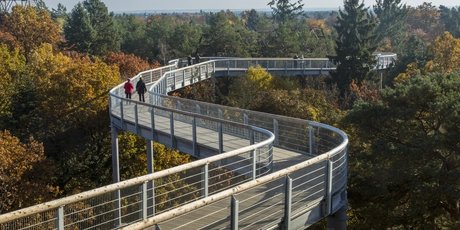
Baumkronenpfad Beelitzer Heilstätten
A Journey Back in Time
Just outside the gates of the German capital Berlin stretches a wonderfully enchanted area: the Beelitzer Heilstätten.
Ancient trees and enchanted buildings: here the past catches up with you
If you've ever set foot on the grounds of the largely abandoned site of the Beelitz Sanatorium, you're familiar with its eerie charm. The buildings have been left to crumble slowly while the rambling old forested gardens take visitors back through the ups and downs of the 20th century. Nature, history, and architecture have begun to meld together in this spot into what some might call a masterpiece.

High in the treetops
In September 2015, the first treetop path in Brandenburg was opened on the grounds of this former sanatorium for women with tuberculosis. The path runs along the top of the forest some 23 metres in the air for more than 300 metres past the ruins of the sanatorium pavilion, now overgrown. Climb the 36 metre high observation tower to enjoy impressive panoramic views of the landscape.

Right at the gates of the German capital
Today, many people from the city head this way during their spare time to relax and get a workout amidst the natural surroundings. But at the very end of the 19th century, this 140 ha woodland sanatorium and park was a place for a very different kind of recovery for Berliners suffering from tuberculosis. The crowded tenements of Berlin led to countless cases of TB and sanatoria like Beelitz offered clean air intended to help them recover. The forests around Beelitz, just 50 km from central Berlin, were ideally suited for this purpose.
Like a small town all its own
The sanatorium site was enlarged in 1928, adding a surgical hospital, a laundry, and even a small shopping arcade with six stores (a cobbler, a stationer, a soap workshop, a bakery, and a tailor). Soon there was room for 1,300 patients.
Soviet army and the communist era
After serving as a German military hospital during the Second World War , the site was taken over by the Red Army in 1945 and remained the Soviets' largest military hospital outside the USSR until 1994. In December 1990, Erich Honecker, the recently deposed leader of East Germany, and his wife were given shelter here. Since the withdrawal of the Red Army in 1994, the site has been left to decay.
